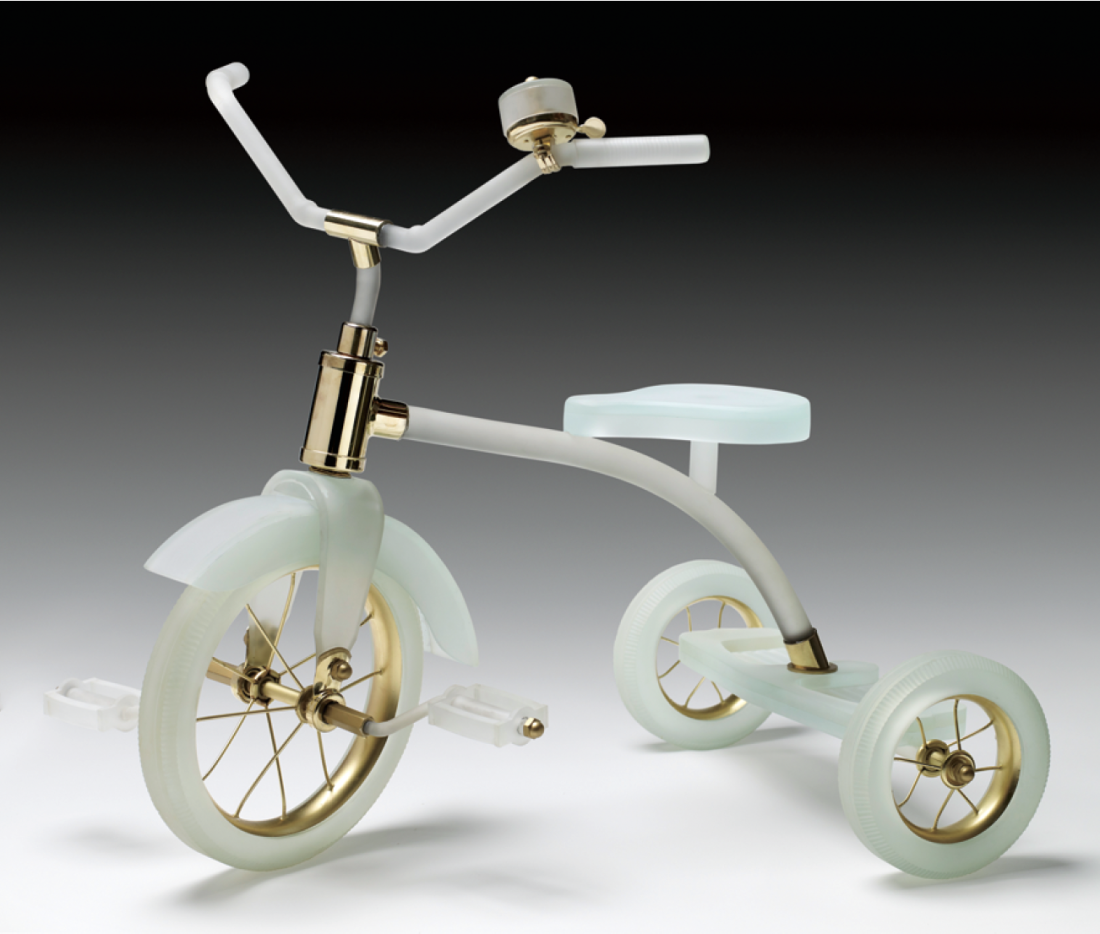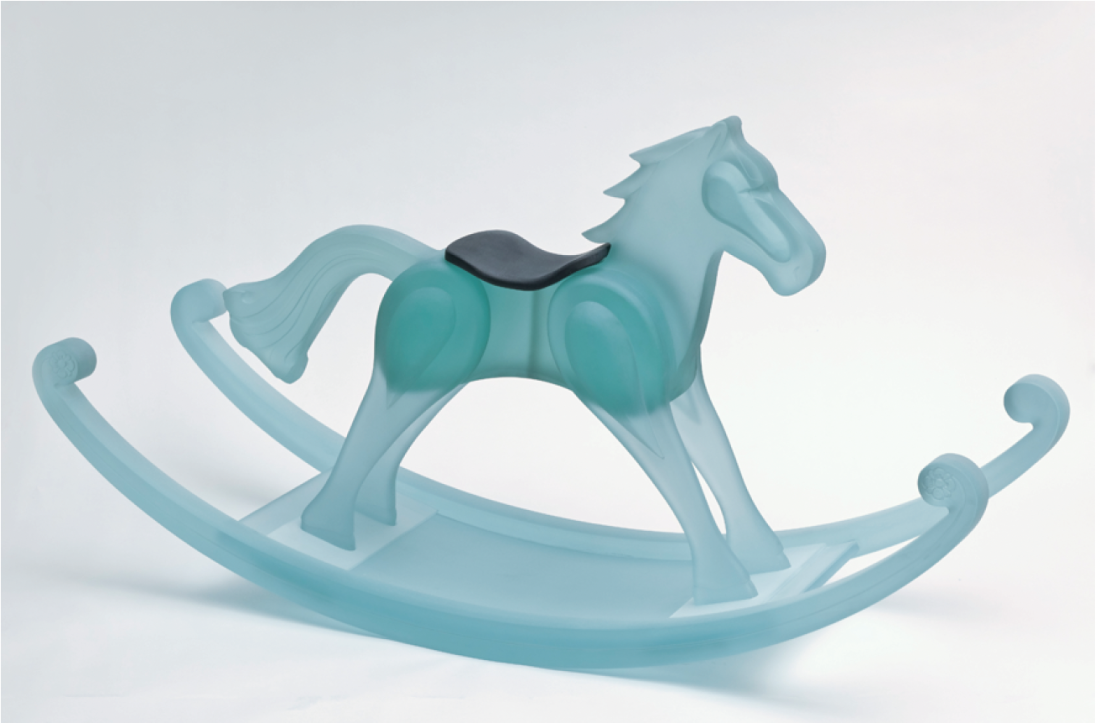Tim Whiten
Olga Korper’s vast main gallery was transformed into a sacred space in “Tim Whiten: coming PASSAGE going,” an exhibition comprising eleven modestly sized and retiring, though theatrically presented, works. The net effect was an operatic treatment of common items, but this is Whiten’s point: to find the mystical and personal in the quotidian.
Continuing a series of glass-cast tools, this show includes T After Tom (spade) and T After Tom (pickaxe), both 2010, whose crystal is sandblasted to make them opaque, yet ghostly. While these are hardly readymades, Whiten conjures Marcel Duchamp’s spirit and this Modernist’s preoccupation with transformation and alchemy, namely the conversion of the everyday to “art.” The tools are poetic—their thick glass is strong yet vulnerable, physical yet barely there. Leaning against the gallery walls, they seem casually left behind; in their transubstantiation from wood and metal, they become symbols for change in their own right—numinous technology. Whiten has spoken of such tools and domestic objects as homage to his parents who were a carpenter and homemaker; thus they also take on memorial gravity.

Tim Whiten, After Ethan’s Wheels, 2010, cast glass, brass fittings, 26 x 21 x 30”. Photographs courtesy of Olga Korper Gallery, Toronto.
He is Called Spagyrist, 2010, is a tour-de-force of craftsmanship in which a birdcage is fabricated in glass; its only denizen is a flat mirror cut into a bird silhouette. Presumably, “Spagyrist,” an archaic word for “alchemist,” is the name of the reflective bird, but this term might also be applied to the fabricator who changed this homely object into something fantastic, or the artist who willed it into being. In any case, birds are symbols for souls across many cultures; this one happens to occupy a vitreous skeleton (a rib cage) that occludes the bird to the point that it disappears. The avian form seems more physical in the dramatic illumination’s shadow play.
Some objects in this show are Whiten’s latest entries in his body of works that read as “ritualistic.” Rebis i and Rebis ii, both 2010, are glass boats each containing a human skull, but Rebis ii’s cranium is covered in tightly stretched black leather. The boat is an overdetermined symbol of transformation since many cultures feature water crossings in mythologies or imaginings of the afterlife. As such, the skull in the crystal boat is an easy read, but more importantly, through these materials Whiten evokes tension between the natural and the engineered, the shamanistic and the rational. For instance, while the vessel itself is a white minimal sculpture, Whiten calculatedly decorates it with scrollwork, the sort of ornament Adolf Loos declared a crime of primitivism.
This show includes works on paper that demonstrate the artist’s abiding concerns for the alchemical and spiritual expressed in physical objects. His abstract works use “elemental” pigments—powdered graphite, coffee, gold and ink to express cosmological forms such as the mandalas of Marclala i & ii, 1978, or his Cosmogram works, 1976. The largest work in this exhibition, After Magic Gestures, 2009–10, shows similar painterly marks loomed into a silk-and-wool carpet and “stained” with coffee and ink marks and illegible calligraphy. Again, Whiten evokes pictographs and ancient language fragments that maintain their mystery. By association, the carpet, too, is a household item that carries profound symbolism, often abstract, within many cultures.

Tim Whiten, Lucky, Lucky, Lucky, 2010, hand cut glass, 42.5 x 23 x 13”.
Two charming glass toys steal this show, especially as they are so well crafted as to be almost functional. After Ethan’s Wheels, 2009–10, is a life-sized tricycle held together with brass fittings and completed with a bike bell. The green hobby horse, Lucky, Lucky, Lucky, 2010, is hand-cut glass and an allusion to an enchanted, luminous and demonic object from a D H Lawrence tale, “Rocking Horse Winner,” 1926. In their translucency and optical softness, the trike and rocking horse are also physical manifestations of shadow memories—an adult’s romanticization of childhood. Their pristine condition lends a fetishistic aura, especially as the seats are crafted to fit children’s bodies but will likely never hold them. In their perfection, they come off as funerary, and like new toys buried with children in ancient Egypt, they are melancholic, magical and ideal.
Whiten continues to emphasize art’s ritual aspects. It’s easy to see anthropological binaries between his raw and cooked, “primitive” and “civilized” materials, but musing on them makes one realize that contemporary art practices—whether creating, gathering critical manna or collecting—are variations on millennia-old rituals. Whiten evokes numinous readings of his works, especially through abstraction, materials such as skins, glass and skulls, or allusions to objects such as masks and reliquaries. All carry religious symbolic value even if they don’t point to any one faith. Though spiritual transformation is an important theme in this show, Whiten powerfully asserts that through history and across cultures, the whys and wherefores of making and owning art—for wonder, status, for a taste of the eternal—have remained remarkably stable. ❚
“Tim Whiten: coming PASSAGE going” was exhibited at the Olga Korper Gallery in Toronto from January 29 to February 26, 2011.
William Ganis is a professor of art history and gallery director at Wells College, New York.

